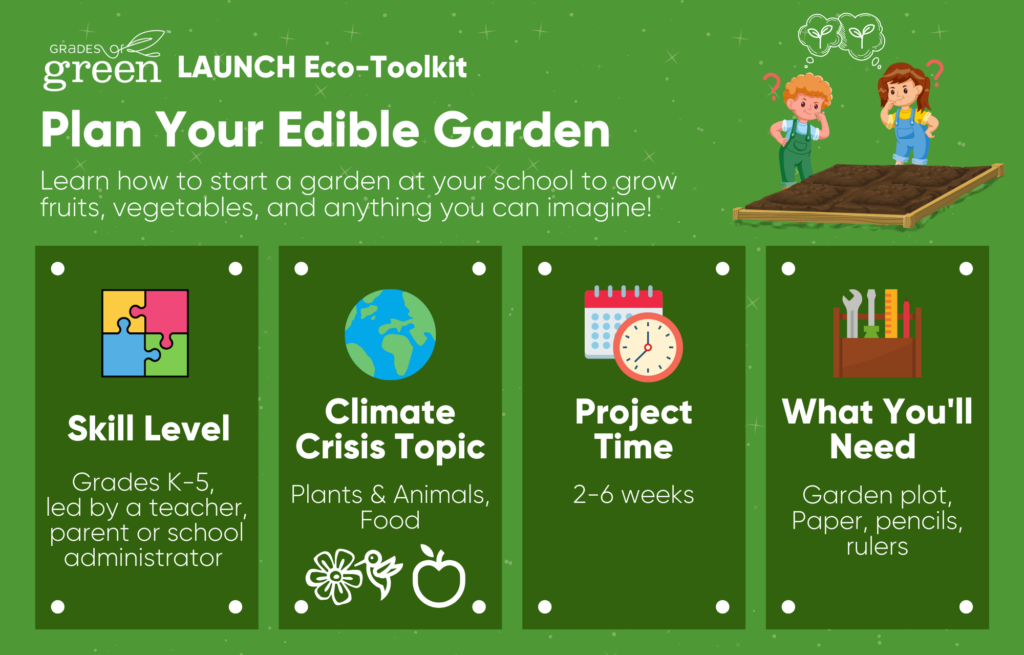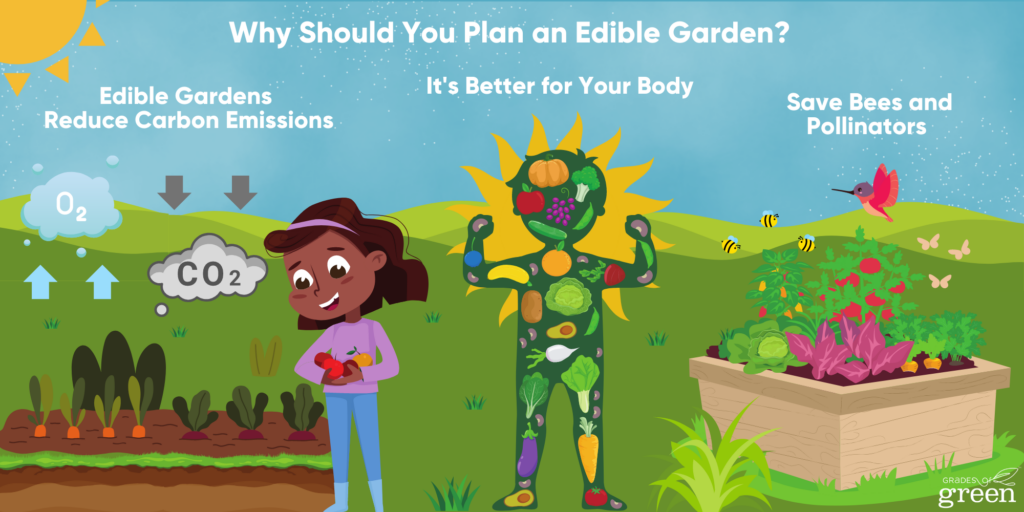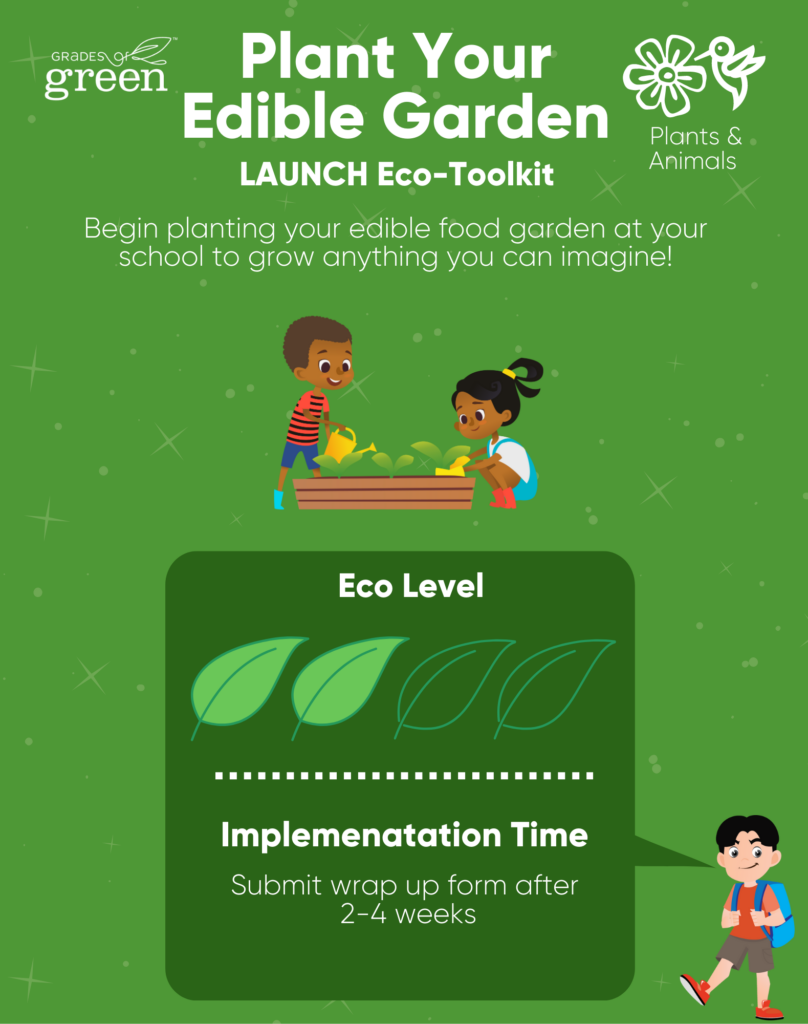All good projects start with a PLAN!
In the first toolkit of the Edible Garden series, students will learn how to create an effective plan to grow an edible garden. They will also discover the positive impacts edible gardens have on the environment.
Grades of Green is proud to partner with Palos Verdes School Gardens and Kellogg Garden Products to bring you this toolkit.

Toolkit Details


NGSS
This toolkit address the following Science and Engineering Practices (SEPs) within the Performance Expectations of NGSS for Grades: K-2 and 3-5
- Asking Questions and Defining a Problem
- Planning and Carrying out Investigations
- Analyzing and Interpreting Data
- Using Mathematics and Computational Thinking
- Constructing Explanations and Designing Solutions
- Obtaining Evaluating, and Communicating Information
Learning Objectives
- Analysis
- Students will analyze their campus and determine best practices.
- Project Management
- Students will keep track of progress and care for a living plant.
- Students will practice leadership skills by delegating tasks to each other.
- Evaluation and Assessment
- Students will track and evaluate the impact of their project.
What is an Edible Garden & Why is it Important?
An edible garden is a garden where you can eat what you grow! Edible gardens that are organic do not use harmful pesticides (a substance used to remove insects/pests and can also hurt plants and animals). Organic gardens contain healthy soil that removes CO2 from our atmosphere and eliminates dangerous chemicals and toxins that can occur on commercial produce.
What You Will Accomplish
Students will be able to create a plan for their school edible garden by finding an ideal spot for a garden plot, determining what they should plant and where the seeds should go. They will also plan out a schedule for the initial soil work, planting, and maintenance (details on implementing these activities follow in the additional toolkits).
Educator Project Plan
Follow the steps below to set up a successful Edible Garden at your school! Need help? Contact us!
Track your metrics and submit your impact after implementing this toolkit. Your feedback helps keep our programs free for all across the globe.
Determine Participants
Use the Edible Garden Sign Up Sheet to have participants sign up.
- A Student Group such as (a club, before/after school program, non-school organization)
- A whole class
- The whole school
- An adult garden committee to support the students: Custodial staff, teachers, administrators, parent volunteers
- Working in a small student group? Determine roles for each student
- A Whole class? Divide the class into groups to lead different tasks
- The Whole school? Have a core group of student leaders to implement tasks and educate the rest of the students during an assembly or walking assemblies
Why Should You Plan an Edible Garden
The resources provided below can be shown as a slideshow or printed out as individual worksheets for students to review.

Edible Gardens Reduce Carbon Emissions
Growing food in a school, home, or community garden reduces carbon emissions. Transporting fruits and vegetables from a farm to our markets means trucks, planes, and ships are producing carbon emissions, which are harmful to our planet. In fact, food transportation creates one fifth of the total emissions of the food industry. Also, fresh-picked food from a garden doesn’t need plastic packaging! [1]
It’s Better for Your Body
Garden-grown food is better for our health. Because we pick our fruits and vegetables later on in the growth cycle, there’s more nutrients in garden produce than large-scale agriculture produce. Plus, you save money! [2]
Save Bees & Other Pollinators
Growing your own food without pesticides, including herbicides, supports local ecosystems. According to The Bee Conservancy, harmful pesticides are a leading cause of pollinator declines. [3] By growing fruits and vegetables, you can provide a safe haven for pollinators (who are really important for the earth’s ecosystems!)
Why Food is a Social Justice Issue
Food Deserts (or areas where it’s hard to get fresh food and produce) and food swamps (areas that lack fresh food/produce but offer a lot of unhealthy and fast foods) are environmental justice issues. People who live in communities with limited access to fresh produce and whole foods, often consume more processed/fast food than fresh food. These types of foods take more energy to produce and transport and release carbon emissions unlike their nutritious counterparts – fresh fruits and vegetables. Access to fresh fruits and vegetables to all can not only improve health but it is also better for our planet. [4]
Watch these Short Videos to Learn More on Planning a Garden
Think About It!
Pre-Activity Questions
- What are the benefits of creating a garden plan?
- What are some of the environmental benefits that can be addressed in our plan?
- What are some details that we should include in our plan?
- What are some organizations we can connect with to support our plan?
Take Action: Create a Plan to LAUNCH an Edible Garden
Lead students through the Plan an Edible Garden activity with guided instructions. Check out “Pro Tips” for additional help.
1. Assign Roles
Using the Edible Garden Roles Worksheet, assign or allow students to pick roles in order to plan a garden. Some roles can include:
- Outreach Specialist
- Garden Planner
- Plant Picker
Feel free to add more roles and get creative with the names to make it more fun!
2. Meet Your School’s Decision Makers
Have students set up a meeting with their principal and custodial staff to obtain permission for an edible garden.
3. Map It Out
Look at a map of the school or neighborhood. Make a list of areas that could work and benefit from an edible garden. Make sure you choose a spot that is easy to get to and gets at least 6 hours of direct sunlight daily.
Creating more than one garden? Have the students name them to create a sense of pride and ownership!
4. Decide Your Garden Type
Decide what kind of garden works best for space and climate:
- Raised beds are large containers built on top of the ground. One benefit is it is easy to control soil quality.
- Using Raised Beds? Use this guide!
- Containers: Unlike Raised Beds, containers have a bottom and require proper drainage
- In Ground: If possible, test your soil if you plan to plant your seeds directly in the ground
- Learn about different soils to use here for your type of garden.
- Use this guide for tips on How to check for soil pH
If you build raised beds or containers and add your own soil, you do not have to test ground soil for possible contaminants. Ground plots may need compost or soil amendment added to provide the nutrients it will need to grow food.
5. Determine Your Climate Zone and Seeds
Before you pick your seeds, you first need to determine what “Climate Zone” you live in. Different areas have different types of climate and are suitable for different plants. Refer to How to Find Your Planting Zone from Kellogg Garden: https://www.kellogggarden.com/blog/gardening/how-to-find-your-planting-zone/
Next, use this resource to learn about what plants will work best for your Edible Garden:
Download free Kellogg Planting Charts based on your Climate Zone to find what seeds work best for your garden (Zone Planting Charts can be downloaded as google spreadsheets that you can edit and customize!). Help decide what seeds to plant by visiting Kellogg Garden’s Edible Garden page. Check out these 10 tips for Designing your Garden Layout!
- Learn new terms! “Perennials” regrow every year while “annuals” only grow for one season and die off
- Get more tips on planning your garden on Kellogg Garden’s website
6. Create a Grid
Choose the seeds you want to plant and remember you can always add more, so start small. Use this worksheet to create a grid for your seeds.
- Start with rows that go run North/South to ensure they receive the most sunlight.
- Make sure to have enough space around each seed so your plants can grow (different plants need different spacing, research how much space the plants you are growing will need).
7. Obtain and Prep Your Materials
Next, you must gather the materials you will need to create your garden! This can include:
- Seeds
- Soil
- Mulch
- Small Hand Shovels
- Trowels
- Garden Rake
- Garden gloves
- Watering cans
- Plant labels such as Popsicle sticks
If you need resources on how to gather materials, here are some ideas:
- Contact local nurseries or big box stories such as Home Depot and Lowes to see if they will donate supplies.
- Reach out to school parents and teachers for donations as well.
If you would prefer to purchase the materials, but need funding, check out these lists of available grants:
- Seed Your Future: Educator Garden Grants
- Kids Gardening External Opportunities: https://kidsgardening.org/grant-opportunities/
8. Maintenance Plan
Look to student and adult volunteers to determine how the garden will be maintained (watered, fertilized, weeded, and harvested) throughout the school year and during school breaks. How will tasks and garden responsibilities be divided? The whole team/club can separate duties by:
- Assigning raised beds by grade level, class, or club.
- Rotating students on who’s working on the garden.
- What are other ways you can divide the garden responsibilities?
- Remember to use the Edible Garden Roles Worksheet mentioned previously!
A more extensive maintenance plan is outline is Toolkit #3 of this garden series. Dive deeper into planning using this awesome resource from Kids Gardening: Seeds of Success | KidsGardening
Reflection Questions
How’d It Go?
- What was the hardest part about the planning process?
- Which next step are you most excited about?
- What changes will you make the next time you are creating a plan?
Report Students’ Impact
Congratulations!! You’ve Planned an Edible Garden! Don’t let all that hard work go unnoticed. Submit your results by clicking the green button below.
By reporting your impact, Grades of Green can:
- CELEBRATE and elevate your students’ hard work and success.
- Offer our programs FREE for all students across the globe.
- AWARD stipends and certificates to hard-working educators and students.
Please take a few minutes to submit your results. Thank you!
Next Steps
Congrats on Planning Your Edible Garden! Get started on Toolkit #2: Plant Your Edible Garden!

Provided Resources
- Edible Garden Series Google Resources
- Edible Garden Series Sign Up Sheet
- Edible Garden Series Roles Worksheet
- Edible Garden Series Grid Plan
- Plan Your Edible Garden Slides
- Plan Your Edible Garden Wrap Up Form
Did you enjoy this toolkit? Get ready to plant your edible garden!